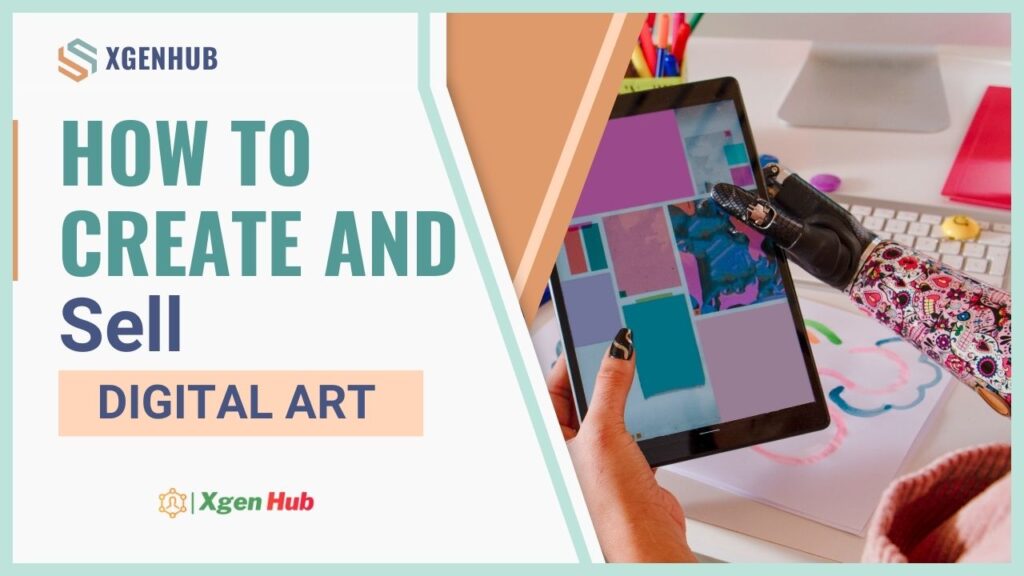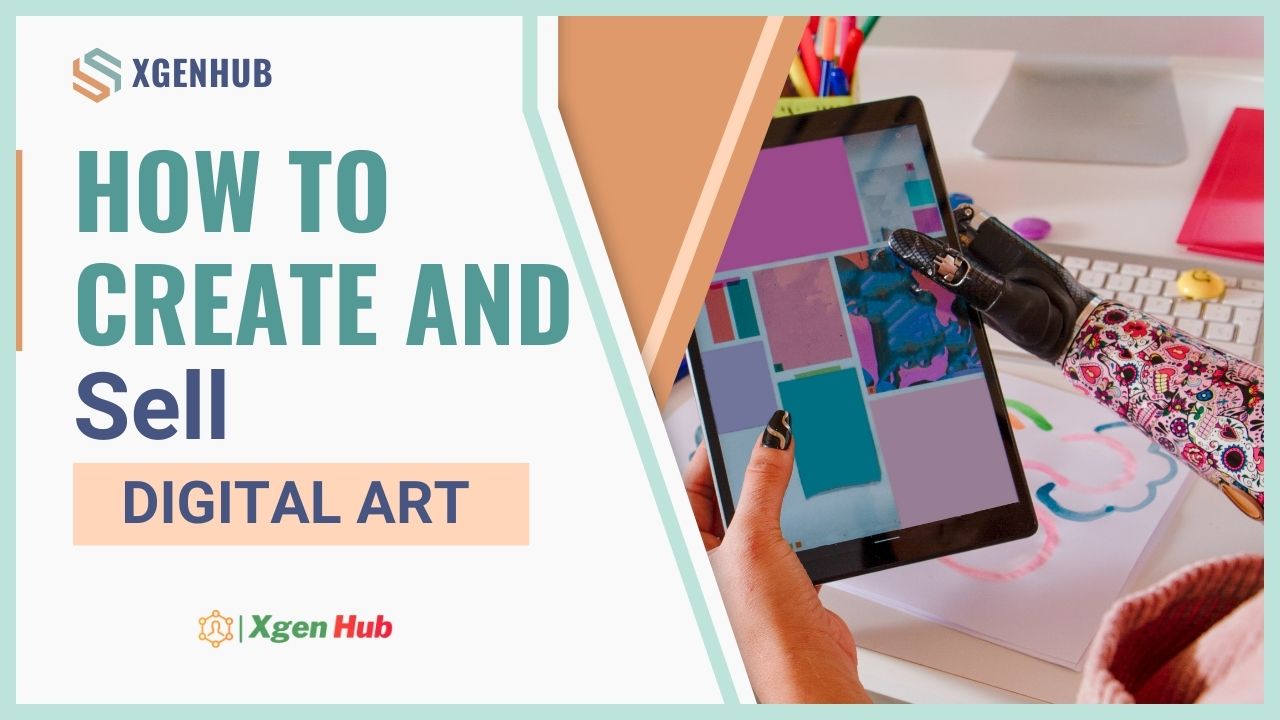Hey I’m Inzamul, Welcome to my article today I am going to breakdown How to Create and Sell Digital Art
The digital age has opened a treasure trove of opportunities for artists. Gone are the days of relying solely on galleries or physical sales. Today, with a drawing tablet, some creativity, and the right approach, you can turn your artistic passion into a thriving online business selling digital art.
No #1 Work From Home 500$ A Day Opportunity Start Earning Today!

This comprehensive guide will equip you with everything you need to know, from honing your craft to establishing a successful digital art empire. So, whether you’re a seasoned artist or just starting your artistic journey, buckle up and get ready to unleash your creativity on the digital world!
Understanding the Rise of Digital Art
No #1 Work From Home 500$ A Day Opportunity Start Earning Today!
In recent years, digital art has emerged as a prominent and influential form of artistic expression. With advancements in technology and the widespread accessibility of digital tools, artists around the world are embracing this medium to unleash their creativity in new and exciting ways. This guide aims to provide aspiring digital artists with a comprehensive roadmap for creating and selling their artwork in the digital landscape.
Getting Started with Digital Art
1. Choosing the Right Tools and Software
1.1 Exploring Digital Drawing Tablets
Selecting the perfect digital drawing tablet is crucial for any aspiring digital artist. Consider factors such as pressure sensitivity, pen responsiveness, and screen size to find a tablet that suits your artistic preferences and budget.
1.2 Selecting the Ideal Software for Digital Art
With a plethora of software options available, it’s essential to choose a digital art program that aligns with your artistic goals and workflow. Whether you prefer raster-based software like Adobe Photoshop or vector-based programs like Adobe Illustrator, exploring different software packages can help you find the right fit for your needs.
2. Mastering Basic Digital Art Techniques
2.1 Understanding Layers and Brushes
Layers and brushes are fundamental elements of digital art creation. Learning how to effectively utilize layers for organization and experimentation, as well as mastering the use of various brushes for different effects and textures, can significantly enhance your digital art skills.
2.2 Experimenting with Different Styles and Techniques
Digital art offers endless possibilities for experimentation and exploration. Take advantage of this flexibility by trying out different art styles, techniques, and digital effects to discover your unique artistic voice and style.
Creating Your Digital Art
3. Finding Inspiration and Developing Your Style
3.1 Exploring Different Art Styles and Genres
Immerse yourself in the world of art by exploring various styles, genres, and artistic movements. Draw inspiration from classical art, contemporary trends, and even pop culture to develop a diverse and versatile artistic repertoire.
No #1 Work From Home 500$ A Day Opportunity Start Earning Today!
3.2 Drawing Inspiration from Other Artists and Artworks
Don’t be afraid to draw inspiration from other artists and their works. Studying the techniques and styles of established artists can provide valuable insights and inspiration for your own artistic journey.
4. Practicing Consistently to Improve Your Skills
4.1 Setting Regular Practice Sessions
Like any skill, digital art requires consistent practice and dedication to improve. Set aside dedicated time for daily or weekly practice sessions to hone your skills and refine your artistic techniques.
4.2 Seeking Feedback and Critique to Grow
Seeking feedback and critique from peers, mentors, and online communities is essential for growth as a digital artist. Constructive criticism can help you identify areas for improvement and refine your artistic vision.
Showcasing and Marketing Your Art
5. Building Your Online Presence
5.1 Creating a Portfolio Website or Online Gallery
A professional portfolio website or online gallery is essential for showcasing your digital art to potential clients and collaborators. Invest time in creating a visually appealing and user-friendly platform to showcase your artwork effectively.
5.2 Utilizing Social Media Platforms for Promotion
Social media platforms like Instagram, Twitter, and TikTok offer powerful tools for promoting your digital art to a global audience. Create engaging content, interact with your followers, and leverage popular hashtags to increase visibility and reach.
6. Optimizing Your Art for Online Platforms
6.1 Understanding Image Resolution and Formats
Optimizing your digital artwork for online platforms requires an understanding of image resolution, file formats, and compression techniques. Ensure your artwork maintains high quality and clarity across different devices and screen sizes.
6.2 Creating Captivating Thumbnails and Descriptions
Effective presentation is key to attracting viewers to your digital artwork. Craft compelling thumbnails and descriptive captions that entice viewers and provide context for your artwork, increasing engagement and interest.
Selling Your Digital Art
7. Exploring Different Revenue Streams
7.1 Selling Prints and Merchandise
Beyond digital sales, consider expanding your revenue streams by selling prints, merchandise, or licensing your artwork for commercial use. Platforms like Society6, Redbubble, and Etsy offer opportunities to monetize your digital art in various formats.
No #1 Work From Home 500$ A Day Opportunity Start Earning Today!
7.2 Licensing Your Artwork for Commercial Use
Licensing your digital artwork for commercial use can be a lucrative opportunity for artists. Explore licensing agreements with companies, brands, and publishers to leverage your artwork for products, advertisements, and other commercial projects.
8. Setting Up an Online Store or Marketplace Presence
8.1 Choosing the Right Platform for Selling
When setting up an online store or marketplace presence, consider factors such as fees, audience demographics, and ease of use. Platforms like Shopify, Etsy, and Gumroad offer customizable solutions for selling digital art and managing transactions.
8.2 Setting Prices and Managing Transactions
Determining pricing for your digital artwork requires careful consideration of factors such as production costs, market demand, and perceived value. Research pricing trends in your niche and adjust your prices accordingly to maximize profitability while remaining competitive in the market.
Legal and Ethical Considerations
9. Understanding Copyright and Intellectual Property Rights
9.1 Protecting Your Artwork from Unauthorized Use
As a digital artist, protecting your artwork from unauthorized use and infringement is paramount. Familiarize yourself with copyright laws, watermark your artwork, and consider registering your copyrights to safeguard your intellectual property rights.
9.2 Respecting the Rights of Other Artists and Creators
In addition to protecting your own rights, it’s essential to respect the rights of other artists and creators. Avoid plagiarism, seek permission before using others’ work, and adhere to copyright and licensing agreements to maintain ethical standards in the digital art community.
Conclusion
Creating and selling digital art is a fulfilling and rewarding endeavor that offers endless opportunities for creativity and expression. By mastering digital tools and techniques, building a strong online presence, and understanding the legal and ethical considerations of the digital art industry, aspiring artists can turn their passion into a thriving career.
Unique FAQs:
No #1 Work From Home 500$ A Day Opportunity Start Earning Today!
- Can I create digital art without any prior artistic skills? Absolutely! Digital art provides a versatile and accessible medium for artists of all skill levels to express themselves creatively and explore new artistic horizons.
- What are some common challenges faced by digital artists? Common challenges for digital artists include mastering complex software tools, managing time effectively, and navigating the competitive landscape of the digital art market.
- How can I stay motivated and inspired as a digital artist? Surround yourself with a supportive community of fellow artists, seek inspiration from diverse sources, and set achievable goals to maintain motivation and momentum in your artistic journey.
- What are the benefits of selling digital art online compared to traditional methods? Selling digital art online offers greater flexibility, scalability, and accessibility compared to traditional gallery exhibitions or art fairs. Online platforms provide a global audience and the potential for passive income streams, making it an attractive option for digital artists.
- Are there any legal considerations I should be aware of when selling digital art? Yes, it’s crucial to understand copyright laws, licensing agreements, and intellectual property rights to protect your artwork and avoid legal disputes. Consult with legal professionals or organizations specializing in artist rights for guidance on navigating legal issues in the digital art industry.
Thanks for read my article, How to Create and Sell Digital Art

xnxx